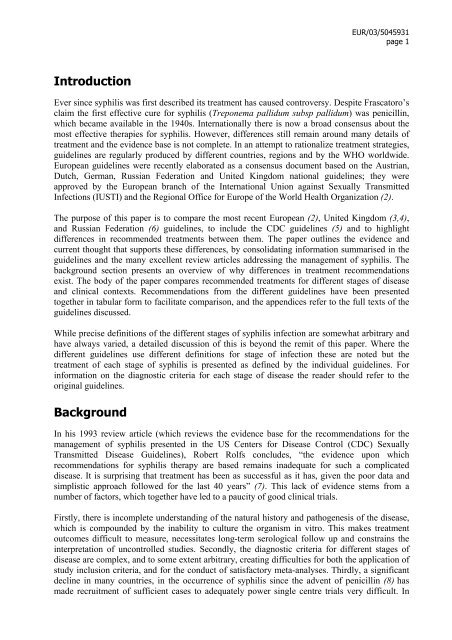Review of Current Evidence and Comparison of Guidelines for ...
Review of Current Evidence and Comparison of Guidelines for ...
Review of Current Evidence and Comparison of Guidelines for ...
Create successful ePaper yourself
Turn your PDF publications into a flip-book with our unique Google optimized e-Paper software.
Introduction<br />
EUR/03/5045931<br />
page 1<br />
Ever since syphilis was first described its treatment has caused controversy. Despite Frascatoro’s<br />
claim the first effective cure <strong>for</strong> syphilis (Treponema pallidum subsp pallidum) was penicillin,<br />
which became available in the 1940s. Internationally there is now a broad consensus about the<br />
most effective therapies <strong>for</strong> syphilis. However, differences still remain around many details <strong>of</strong><br />
treatment <strong>and</strong> the evidence base is not complete. In an attempt to rationalize treatment strategies,<br />
guidelines are regularly produced by different countries, regions <strong>and</strong> by the WHO worldwide.<br />
European guidelines were recently elaborated as a consensus document based on the Austrian,<br />
Dutch, German, Russian Federation <strong>and</strong> United Kingdom national guidelines; they were<br />
approved by the European branch <strong>of</strong> the International Union against Sexually Transmitted<br />
Infections (IUSTI) <strong>and</strong> the Regional Office <strong>for</strong> Europe <strong>of</strong> the World Health Organization (2).<br />
The purpose <strong>of</strong> this paper is to compare the most recent European (2), United Kingdom (3,4),<br />
<strong>and</strong> Russian Federation (6) guidelines, to include the CDC guidelines (5) <strong>and</strong> to highlight<br />
differences in recommended treatments between them. The paper outlines the evidence <strong>and</strong><br />
current thought that supports these differences, by consolidating in<strong>for</strong>mation summarised in the<br />
guidelines <strong>and</strong> the many excellent review articles addressing the management <strong>of</strong> syphilis. The<br />
background section presents an overview <strong>of</strong> why differences in treatment recommendations<br />
exist. The body <strong>of</strong> the paper compares recommended treatments <strong>for</strong> different stages <strong>of</strong> disease<br />
<strong>and</strong> clinical contexts. Recommendations from the different guidelines have been presented<br />
together in tabular <strong>for</strong>m to facilitate comparison, <strong>and</strong> the appendices refer to the full texts <strong>of</strong> the<br />
guidelines discussed.<br />
While precise definitions <strong>of</strong> the different stages <strong>of</strong> syphilis infection are somewhat arbitrary <strong>and</strong><br />
have always varied, a detailed discussion <strong>of</strong> this is beyond the remit <strong>of</strong> this paper. Where the<br />
different guidelines use different definitions <strong>for</strong> stage <strong>of</strong> infection these are noted but the<br />
treatment <strong>of</strong> each stage <strong>of</strong> syphilis is presented as defined by the individual guidelines. For<br />
in<strong>for</strong>mation on the diagnostic criteria <strong>for</strong> each stage <strong>of</strong> disease the reader should refer to the<br />
original guidelines.<br />
Background<br />
In his 1993 review article (which reviews the evidence base <strong>for</strong> the recommendations <strong>for</strong> the<br />
management <strong>of</strong> syphilis presented in the US Centers <strong>for</strong> Disease Control (CDC) Sexually<br />
Transmitted Disease <strong>Guidelines</strong>), Robert Rolfs concludes, “the evidence upon which<br />
recommendations <strong>for</strong> syphilis therapy are based remains inadequate <strong>for</strong> such a complicated<br />
disease. It is surprising that treatment has been as successful as it has, given the poor data <strong>and</strong><br />
simplistic approach followed <strong>for</strong> the last 40 years” (7). This lack <strong>of</strong> evidence stems from a<br />
number <strong>of</strong> factors, which together have led to a paucity <strong>of</strong> good clinical trials.<br />
Firstly, there is incomplete underst<strong>and</strong>ing <strong>of</strong> the natural history <strong>and</strong> pathogenesis <strong>of</strong> the disease,<br />
which is compounded by the inability to culture the organism in vitro. This makes treatment<br />
outcomes difficult to measure, necessitates long-term serological follow up <strong>and</strong> constrains the<br />
interpretation <strong>of</strong> uncontrolled studies. Secondly, the diagnostic criteria <strong>for</strong> different stages <strong>of</strong><br />
disease are complex, <strong>and</strong> to some extent arbitrary, creating difficulties <strong>for</strong> both the application <strong>of</strong><br />
study inclusion criteria, <strong>and</strong> <strong>for</strong> the conduct <strong>of</strong> satisfactory meta-analyses. Thirdly, a significant<br />
decline in many countries, in the occurrence <strong>of</strong> syphilis since the advent <strong>of</strong> penicillin (8) has<br />
made recruitment <strong>of</strong> sufficient cases to adequately power single centre trials very difficult. In

















